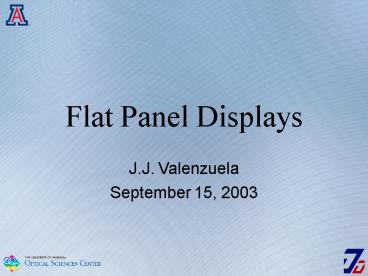Flat Panel Displays - PowerPoint PPT Presentation
1 / 13
Title:
Flat Panel Displays
Description:
Flicker-free -Low heat output -Low energy consumption -No image distortion ... of a house wall, or lighting fixtures may be replaced by white OLED wallpaper. ... – PowerPoint PPT presentation
Number of Views:877
Avg rating:3.0/5.0
Title: Flat Panel Displays
1
Flat Panel Displays
J.J. Valenzuela September 15, 2003
2
What is a display?
-Noah Webster says its an electronic device that
temporarily presents information in visual form.
-Displays have come from cathode-ray tubes all
the way to paper thin plastic with mobile, thin,
and color models of every kind.
3
Flat Panels vs. CRTs
Flat-Panels-Very thin footprint-Lightweight-Fli
cker-free-Low heat output-Low energy
consumption-No image distortion
Cathode-ray Tube (CRT)-Large footprint-Heavy-Sc
reen Refresh Flicker-High heat output-Higher
energy consumption-Image distortion from E-M
fields
4
How does a FPD work?
2 Most Popular Methods
Plasma
Liquid Crystal
5
How does a Liquid Crystal Display work?
-LCDs function on the phenomena of light
polarization. -Incoming light is polarized by one
linear filter-The light travels through a
sandwich of transparent electrodes with liquid
crystal in between-A voltage in the electrodes
changes the orientation of the crystals-The
final polarizer either blocks or transmits the
polarized light
6
The inner-workings of an LCD pixel
Each pixel is made up of a set of red, green, and
blue filters. Passive displays have a cross-grid
of wires that address certain colors of certain
pixels to turn on. Active displays have thin
film transistors on each color element in the
pixel. They are much higher quality.
7
20 LCD TV
8
Plasma Screens
Plasma displays are as thin as LCDs but are
essentially an array of thousands of tiny
fluorescent tubes.
Each plasma screen is made of thousands of pixels
which are in turn made of three individual cells,
each producing its own color. The cross-grid of
the electrodes tells which color of which pixel
to light up and to what brightness.
9
A plasma pixel
-Between a rear glass and a front glass, a cell
of xenon or neon gas is sandwiched between
electrodes.-A voltage sends electrons to ionize
the gas which produces UV light.-Each cell is
filled with red, green, or blue producing
phosphors which convert the UV light.
10
Slim and Trim Plasma TV
11
The Future of FPDs
OLED
Organic Light Emitting Devices -These electrical
devices work like LEDs but use abundant and cheap
organic compounds to produce light.-They are
brighter, more efficient, thinner, cheaper, more
adaptable, live longer, and have a higher viewing
angle than LCDs.
12
OLED Invasion
This smorgasbord of OLED applications is only a
hint at its potential. OLEDs have the ability to
be printed on fabric, plastic, eyeware,
windshields, and everything else that could
benefit from a display. A TV the thickness of a
sheet of paper might one day be the size of a
house wall, or lighting fixtures may be replaced
by white OLED wallpaper.
13
El Fin!































